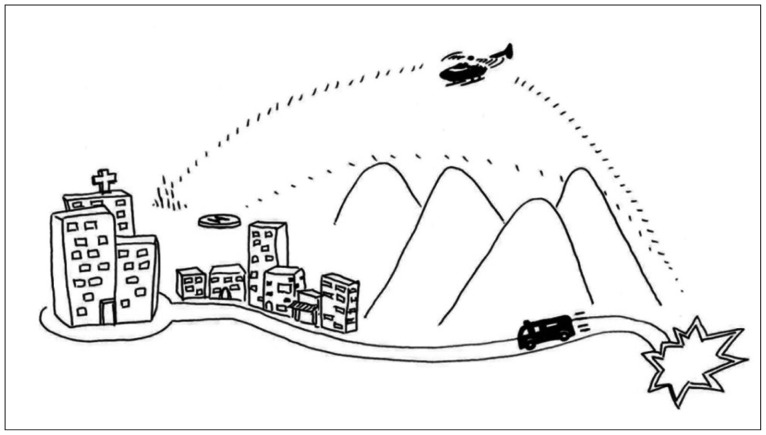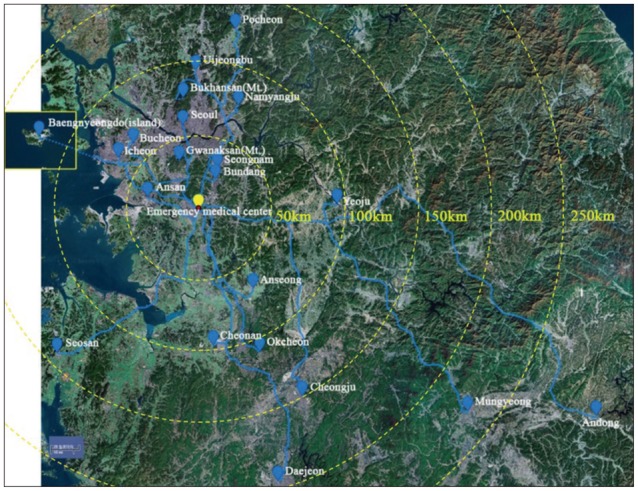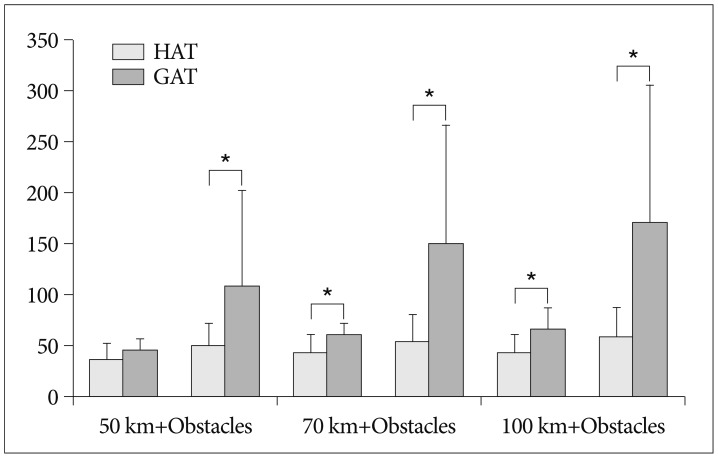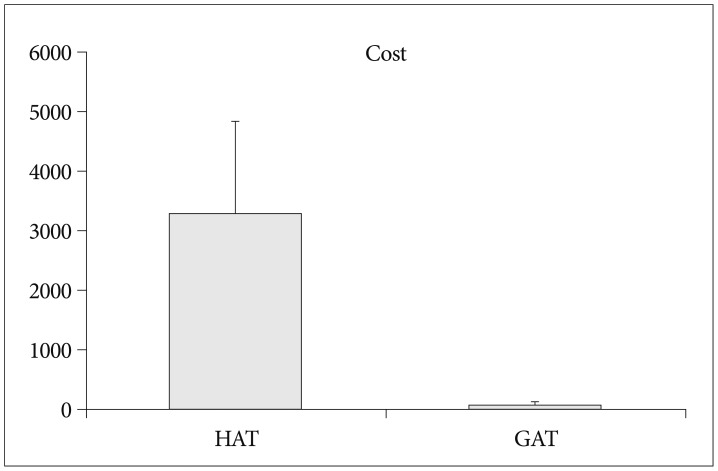J Korean Neurosurg Soc.
2014 Jul;56(1):42-47. 10.3340/jkns.2014.56.1.42.
The Effectiveness Evaluation of Helicopter Ambulance Transport among Neurotrauma Patients in Korea
- Affiliations
-
- 1Department of Neurosurgery, Ajou University College of Medicine, Suwon, Korea. ns9@naver.com
- 2Department of Neurosurgery, Teun Teun Research Institute, Seoul, Korea.
- KMID: 2067075
- DOI: http://doi.org/10.3340/jkns.2014.56.1.42
Abstract
OBJECTIVE
Helicopter ambulance transport (HAT) is a highly resource-intensive facility that is a well-established part of the trauma transport system in many developed countries. Here, we review the benefit of HAT for neurosurgical patients in Korea.
METHODS
This retrospective study followed neurotrauma patients who were transferred by HAT to a single emergency trauma center over a period of 2 years. The clinical benefits of HAT were measured according to the necessity of emergency surgical intervention and the differences in the time taken to transport patients by ground ambulance transport (GAT) and HAT.
RESULTS
Ninety-nine patients were transferred to a single university hospital using HAT, of whom 32 were taken to the neurosurgery department. Of these 32 patients, 10 (31.3%) needed neurosurgical intervention, 14 (43.8%) needed non-neurosurgical intervention, 3 (9.4%) required both, and 11 (34.4%) did not require any intervention. The transfer time was faster using HAT than the estimated time needed for GAT, although for a relatively close distance (<50 km) without ground obstacles (mountain or sea) HAT did not improve transfer time. The cost comparison showed that HAT was more expensive than GAT (3,292,000 vs. 84,000 KRW, p<0.001).
CONCLUSION
In this Korean-based study, we found that HAT has a clinical benefit for neurotrauma cases involving a transfer from a distant site or an isolated area. A more precise triage for using HAT should be considered to prevent overuse of this expensive transport method.
Keyword
MeSH Terms
Figure
Reference
-
1. Babu MA, Nahed BV, Demoya MA, Curry WT. Is trauma transfer influenced by factors other than medical need? An examination of insurance status and transfer in patients with mild head injury. Neurosurgery. 2011; 69:659–667. discussion 667. PMID: 21499151.
Article2. Biewener A, Aschenbrenner U, Rammelt S, Grass R, Zwipp H. Impact of helicopter transport and hospital level on mortality of polytrauma patients. J Trauma. 2004; 56:94–98. PMID: 14749573.
Article3. Bricolo AP, Pasut LM. Extradural hematoma : toward zero mortality. A prospective study. Neurosurgery. 1984; 14:8–12. PMID: 6694798.4. Carlson AP, Ramirez P, Kennedy G, McLean AR, Murray-Krezan C, Stippler M. Low rate of delayed deterioration requiring surgical treatment in patients transferred to a tertiary care center for mild traumatic brain injury. Neurosurg Focus. 2010; 29:E3. PMID: 21039137.
Article5. Chamoun RB, Robertson CS, Gopinath SP. Outcome in patients with blunt head trauma and a Glasgow Coma Scale score of 3 at presentation. J Neurosurg. 2009; 111:683–687. PMID: 19326973.
Article6. Chung CY, Chen CL, Cheng PT, See LC, Tang SF, Wong AM. Critical score of Glasgow Coma Scale for pediatric traumatic brain injury. Pediatr Neurol. 2006; 34:379–387. PMID: 16647999.
Article7. Cunningham P, Rutledge R, Baker CC, Clancy TV. A comparison of the association of helicopter and ground ambulance transport with the outcome of injury in trauma patients transported from the scene. J Trauma. 1997; 43:940–946. PMID: 9420109.
Article8. Intas G, Stergiannis P. Risk factors in air transport for patients. Health Sci J. 2013; 7:11–17.9. McConnell KJ, Newgard CD, Mullins RJ, Arthur M, Hedges JR. Mortality benefit of transfer to level I versus level II trauma centers for head-injured patients. Health Serv Res. 2005; 40:435–457. PMID: 15762901.
Article10. Poon WS, Li AK. Comparison of management outcome of primary and secondary referred patients with traumatic extradural haematoma in a neurosurgical unit. Injury. 1991; 22:323–325. PMID: 1937732.
Article11. Shatney CH, Homan SJ, Sherck JP, Ho CC. The utility of helicopter transport of trauma patients from the injury scene in an urban trauma system. J Trauma. 2002; 53:817–822. PMID: 12435928.
Article12. Spain DA, Bellino M, Kopelman A, Chang J, Park J, Gregg DL, et al. Requests for 692 transfers to an academic level I trauma center : implications of the emergency medical treatment and active labor act. J Trauma. 2007; 62:63–67. discussion 67-68. PMID: 17215734.13. Svenson JE, O'Connor JE, Lindsay MB. Is air transport faster? A comparison of air versus ground transport times for interfacility transfers in a regional referral system. Air Med J. 2006; 25:170–172. PMID: 16818167.
Article14. Taylor C, Jan S, Curtis K, Tzannes A, Li Q, Palmer C, et al. The cost-effectiveness of physician staffed Helicopter Emergency Medical Service (HEMS) transport to a major trauma centre in NSW, Australia. Injury. 2012; 43:1843–1849. PMID: 22898559.
Article15. Teasdale GM, Pettigrew LE, Wilson JT, Murray G, Jennett B. Analyzing outcome of treatment of severe head injury : a review and update on advancing the use of the Glasgow Outcome Scale. J Neurotrauma. 1998; 15:587–597. PMID: 9726258.
Article16. Thomas SH. Helicopter emergency medical services transport outcomes literature : annotated review of articles published 2000-2003. Prehosp Emerg Care. 2004; 8:322–333. PMID: 15295738.
Article17. Thomas SH. Helicopter EMS transport outcomes literature : annotated review of articles published 2004-2006. Prehosp Emerg Care. 2007; 11:477–488. PMID: 17907037.
Article18. Thomas SH, Biddinger PD. Helicopter trauma transport : an overview of recent outcomes and triage literature. Curr Opin Anaesthesiol. 2003; 16:153–158. PMID: 17021454.
Article19. Urdaneta LF, Miller BK, Ringenberg BJ, Cram AE, Scott DH. Role of an emergency helicopter transport service in rural trauma. Arch Surg. 1987; 122:992–996. PMID: 3619629.
Article20. Walcott BP, Coumans JV, Mian MK, Nahed BV, Kahle KT. Interfacility helicopter ambulance transport of neurosurgical patients : observations, utilization, and outcomes from a quaternary level care hospital. PLoS One. 2011; 6:e26216. PMID: 22022572.21. Zafonte RD, Hammond FM, Mann NR, Wood DL, Black KL, Millis SR. Relationship between Glasgow coma scale and functional outcome. Am J Phys Med Rehabil. 1996; 75:364–369. PMID: 8873704.
- Full Text Links
- Actions
-
Cited
- CITED
-
- Close
- Share
- Similar articles
-
- Analysis of the treatment-time reduction of ST elevation myocardial infarction patients transferred by helicopter-based emergency medical services in Korea
- Future development of helicopter emergency medical services in Korea
- Emergency Medical Helicopter - ER in the Sky
- Reduced Mortality in Severely Injured Patients Using Hospital-based Helicopter Emergency Medical Services in Interhospital Transport
- Characteristics of Emergency Patients Transported by Helicopter on Jeju Island






